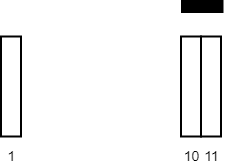- {x}
- Make Array Non-decreasing or Non-increasing
- Largest 3-Same-Digit Number in String
- Count Nodes Equal to Average of Subtree
- Count Number of Texts
- Check if There Is a Valid Parentheses String Path
- Minimum Number of Keypresses
- Find the K-Beauty of a Number
- Number of Ways to Split Array
- Maximum White Tiles Covered by a Carpet
- Substring With Largest Variance
- Find Resultant Array After Removing Anagrams
- Maximum Consecutive Floors Without Special Floors
- Largest Combination With Bitwise AND Greater Than Zero
- Count Integers in Intervals
- Closest Node to Path in Tree
- Percentage of Letter in String
- Maximum Bags With Full Capacity of Rocks
- Read More...

Maximum White Tiles Covered by a Carpet
You are given a 2D integer array tiles where tiles[i] = [li, ri] represents that every tile j in the range li <= j <= ri is colored white.
You are also given an integer carpetLen, the length of a single carpet that can be placed anywhere.
Return the maximum number of white tiles that can be covered by the carpet.
Example 1:

Input: tiles = [[1,5],[10,11],[12,18],[20,25],[30,32]], carpetLen = 10 Output: 9 Explanation: Place the carpet starting on tile 10. It covers 9 white tiles, so we return 9. Note that there may be other places where the carpet covers 9 white tiles. It can be shown that the carpet cannot cover more than 9 white tiles.
Example 2:

Input: tiles = [[10,11],[1,1]], carpetLen = 2 Output: 2 Explanation: Place the carpet starting on tile 10. It covers 2 white tiles, so we return 2.
Constraints:
1 <= tiles.length <= 5 * 104tiles[i].length == 21 <= li <= ri <= 1091 <= carpetLen <= 109- The
tilesare non-overlapping.
Solution Explanation:
This problem asks to find the maximum number of white tiles that can be covered by a carpet of a given length. The solution uses a two-pointer approach combined with sorting and prefix sums implicitly.
Algorithm:
-
Sort: The
tilesarray is sorted based on the starting position (l<sub>i</sub>) of each tile. This allows for efficient processing as we traverse the tiles in ascending order of their starting positions. -
Two Pointers: Two pointers,
iandj, are used to maintain a sliding window.irepresents the starting position of the carpet, andjiterates through tiles that are potentially covered by the carpet. -
Window Maintenance:
- The inner
whileloop expands the window (jincrements) as long as the entire length of the tiles fromtiles[i][0]totiles[j][1]is less than or equal tocarpetLen. During this expansion, the total number of white tiles (s) covered by the current carpet position is updated. - The
ifcondition checks if extending the carpet beyondtiles[j]would cover more white tiles. If it does, theansis updated.
- The inner
-
Sliding Window: After processing tiles covered by the carpet starting at
tiles[i], the outer loop incrementsi, effectively shifting the carpet to the right. The number of tiles covered by the tile atiis subtracted from the running totalsbefore moving to the next tile. -
Return: The maximum number of covered white tiles (
ans) is returned.
Time Complexity: O(N log N), where N is the number of tiles. The dominant factor is the sorting step. The two-pointer approach itself has a linear time complexity.
Space Complexity: O(1). The algorithm uses a constant amount of extra space, regardless of the input size. It modifies the input array in-place.
Example Walkthrough (Python):
Let's trace the Python code with the example: tiles = [[1,5],[10,11],[12,18],[20,25],[30,32]], carpetLen = 10
-
tilesis sorted:[[1, 5], [10, 11], [12, 18], [20, 25], [30, 32]] -
The loop starts:
i = 0,j = 0,s = 0,ans = 0. The inner loop adds[1, 5](s = 5).jbecomes 1.- The condition
tiles[j][1] - tiles[i][0] + 1 <= carpetLen(11 - 1 + 1 <= 10) is false, so the inner loop stops.ansbecomesmax(0, 5) = 5.sis reset to 0. i = 1. The inner loop adds[10,11](s=2),[12,18](s = 2 + 7 = 9),jbecomes 3.tiles[j][1] - tiles[i][0] + 1(25 - 10 + 1 = 16 > 10). The inner loop stops.ansbecomesmax(5, 9) = 9.sis updated.- This process continues until all tiles are checked, and
ansholds the maximum number of covered tiles.
The code in other languages (Java, C++, Go) follows the same algorithm with minor syntactic differences. The key idea is the efficient use of two pointers and sorting to find the optimal carpet placement.